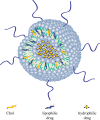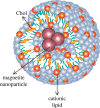Liposomes in tissue engineering and regenerative medicine
- PMID: 25401172
- PMCID: PMC4223894
- DOI: 10.1098/rsif.2014.0459
Liposomes in tissue engineering and regenerative medicine
Abstract
Liposomes are vesicular structures made of lipids that are formed in aqueous solutions. Structurally, they resemble the lipid membrane of living cells. Therefore, they have been widely investigated, since the 1960s, as models to study the cell membrane, and as carriers for protection and/or delivery of bioactive agents. They have been used in different areas of research including vaccines, imaging, applications in cosmetics and tissue engineering. Tissue engineering is defined as a strategy for promoting the regeneration of tissues for the human body. This strategy may involve the coordinated application of defined cell types with structured biomaterial scaffolds to produce living structures. To create a new tissue, based on this strategy, a controlled stimulation of cultured cells is needed, through a systematic combination of bioactive agents and mechanical signals. In this review, we highlight the potential role of liposomes as a platform for the sustained and local delivery of bioactive agents for tissue engineering and regenerative medicine approaches.
Figures












References
-
- LIPID-MAPS. 2014. Lipidomics gateway See http://www.lipidmaps.org.
-
- Mader S. 2010. Inquiry into life, 13, ilustrada edn New York, NY: McGraw-Hill Education.
Publication types
MeSH terms
Substances
LinkOut - more resources
Full Text Sources
Other Literature Sources
